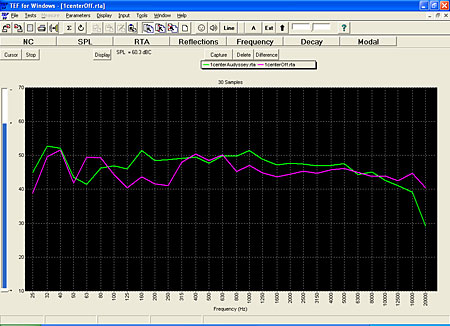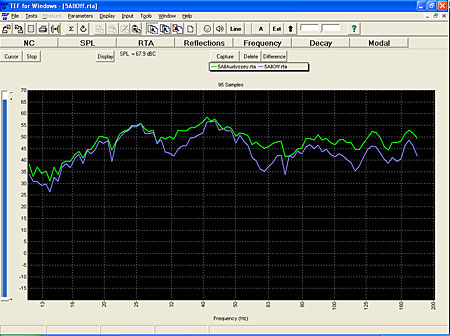| Columns Retired Columns & Blogs |
Music in the Round #17 Page 2
When I swept wideband pink noise from speaker to speaker, it sounded remarkably consistent to my ears and to the RTA display on my new TEF-25 acoustic analysis system. Using the 1-minute pink-noise tracks included on a Telarc SACD of Tchaikovsky's 1812 Overture (Telarc SACD-60541), I graphed the in-room response of the system and its parts using TEF. The response of the Paradigm Studio/60 center speaker, run full-range (fig.1), was representative of all three front speakers and reflects the action of parametric EQ described above. Clearly, MultEQxt (green trace) substantially smoothed the overall frequency response while rolling off the highs above 10kHz compared with the unequalized response (purple trace). The bass still shows a substantial bump between 32 and 40Hz, but MultEQxt has replaced a narrow 50Hz trough with a broader one that bottoms at 63Hz.

Fig.1, In-room, 1/3-octave response, 25Hz–20kHz, of Paradigm Reference Studio/60 center loudspeaker with Audyssey MultEQxt (green) and without (purple) (10dB/vertical div.)
I looked at the bass end (10–200Hz) with somewhat greater resolution (1/24 octave RTA), running pink noise through just the sub via the LFE channel, and then through all channels (fig.2). The two approaches were identical below 50Hz, but MultEQxt (green trace) made a smoother integration between the sub and the other channels across the 80Hz crossover region that was apparent only when pink noise was fed to all channels. As with the wideband traces, it seems that MultEQxt was making only subtle adjustments in the sub-100Hz range. For comparison, the trace in the figure in my November 2005 column (p.50) shows the smooth low-frequency response achieved by the Velodyne SMS-1 EQ with the same amp and speakers. Of course, you can EQ the bass with the Velodyne and then let the Audyssey MultEQxt put it all together.

Fig.2, In-room 1/24-octave response, 10–200Hz, with all speakers active, with Audyssey MultEQxt (green) and without (blue) (5dB/vertical div.)
When I compared EQ=Audyssey with EQ=Off (the latter leaves the bass management, levels, and delays intact), the subjective performance was consistent with the settings and graphs. With a single microphone measurement or eight, MultEQxt made both voices and instruments sound more rich and firmly centered. Soundstaging and imaging were wider and deeper, and it seemed easier to distinguish the ambience of different recording venues. Listening was more relaxed; I didn't feel I needed to keep my head fixed in a narrow "sweet spot" in order to appreciate an accurate and detailed center image. Nor did the smooth rolloff above 10kHz take anything away from cymbals, strings, or those ineffable ambient cues. But then, I don't have a teenager's ears.
However, when I stood way off at the left sidewall, as I do when choosing discs from the shelves, the tonal balance seemed quite overripe, emphasizing that 100–300Hz EQ bump. Another quirk was that MultEQxt seemed very sensitive to slight modifications in room listening acoustics. This makes sense—Audyssey is not simply frequency-domain EQ, but works in the time domain to attempt to compensate for ear-confusing room reflections. With EQ=Off, I could open a door next to the right front speaker on the front wall and, listening only to that speaker, hear a small effect. With EQ=Audyssey, opening the door changed the sound from smooth to a distinct and annoying honkiness—which, of course, I could correct by making a new measurement set with the door open. However, I saw no way to save more than one MultEQxt setting. Nonetheless, MultEQxt was successful over a much larger listening area than that encompassed by the microphone positions.
I vacillated between EQ=Audyssey and EQ=Off. With the former, there was a larger soundspace filled with richer voices and instruments and a remarkably seamless spread of sound around, to, and across the rear. It was consistent in giving me the impression of being in an acoustic space entirely different from my room. EQ=Off, however, seemed clearer and more directly communicative, despite a relatively thinner tonal balance. I felt it did a better job of connecting me with individual performers but was somewhat less good at transporting me to the performance.
I am very familiar with the recordings I used for these comparisons, but that familiarity, of necessity, biased me. I compare the sonic results of any change with my reference impressions, and when there's an improvement, I must work to re-establish a new subjective reference. That said, there was no question that a little manual tweaking of the tonal balances set by MultEQxt could meld the spatial improvements it wrought with a more transparent tonal balance. I hope that Audyssey's much-anticipated standalone equalizer will offer that extended flexibility.
My first receiver
Before I packed up the AVR-4806 receiver for shipping back to Denon, it seemed only fair to give its power amps a chance and to get an overall impression of life with a receiver instead of separate components.
In every aspect of performance, my impression was substantially positive. The AVR-4806's tuner, processor, and preamplifier sections sounded detailed and dynamic, with only the slightest veiling to distinguish them from the best purely analog preamps I've tried. Running the built-in amps in place of my resident Bryston 9B-ST power amp offered a similar contrast: the Denon handled both the Paradigm and the 4-ohm Magnepan speakers without difficulty at all levels. Only with huge transient dynamic outbursts did I feel a slight preference for the Bryston's grip and power.
For the months that the Denon AVR-4806 has been here, it has carried the entertainment load, pleasing me and my guests with music and movies. Never did I feel that the lack of separates compromised our enjoyment in any way. Indeed, it's hard to think of a set of separates that would do as well with that the AVR-4806 can do, and cost anywhere near $3500.
But I ain't a receiver guy, especially with everything in my system run by an internal CPU. I like hardwiring. I like input jacks with defined personalities, such as "CD Player," not ones assigned by setup menus. I like choosing my audio and video sources independently, so I can listen to music while watching a football game. I like devices that do one thing only and do it very well. So as good and as pluripotent as the Denon AVR-4806 is, it hasn't completely won me over. I like separates.
- Log in or register to post comments




































